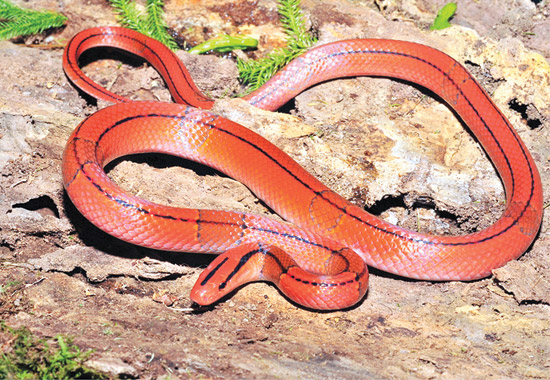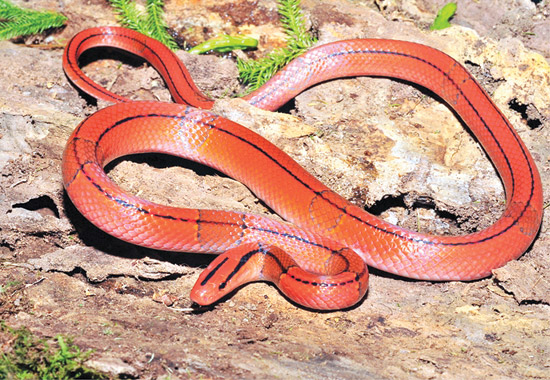(No.2, Vol.3, Mar 2013 Vietnam Heritage Magazine)
206 species of snakes have been discovered and documented in Viet
nam-22 species of sea snakes and 184 terrestrial snakes. Thirty of the terrestrial species are poisonous and so are all of the species of Vietnamese sea snakes.
On the occasion of the New Year of the Snake, I’m pleased to introduce a dozen species of local snakes:
1. Oreocryptophis porphyraceus – Striped snake with red dots (Common name: Red Bamboo Snake)
Oreocryptophis porphyraceus
Considered one of the most colourful snakes in Vietnam, this snake often finds food at forests’ edges, along rivers and on high mountains. Active at sunrise or sunset, their main diet is amphibians and small rodents. Because of their brilliant beauty and harmlessness, they are being desperately hunted for trade and keeping as pets. This species has now been written on the Vietnam Red Data Book.
2. Viridovipera vogeli – Southern Vietnam Green Snake (Common name: Vogel’s Pit Viper)
Viridovipera vogeli
One of the most talented and smartest night predators in the snake world, this kind of snake uses infrared sensitivity to hunt at night in rainforests. It will wrap around trunks or small branches on the ground and patiently wait for its prey to come by. With one bite of its sharp teeth, its prey is finished. This is a deadly snake which is very dangerous, not only to deer but also humans.
3. Ovophis monticola – Mountain Green Snake (Common name: Chinese mountain Pit Viper)
Ovophis monticola
An extremely poisonous snake to warm-blooded animals, this snake lies quietly in the morning light, so it is hard to see. It hides in mornings and hunts at night near where small puddles stagnate in evergreen forests. With different environments come different coloring-above 800m, the black streaks on their heads make it easy to distinguish from other snakes in the Ovophis genus in Vietnam.
4. Pareas carinatus (Common name: Keeled Slug-eating snake)
Pareas carinatus
At Vinh Cuu Nature Reserve, Dong Nai Province, Southern Vietnam, when the temperature goes down at night, this snake will crawl out of its cave and start to hunt. Rhacophorus tree frogs and other small frogs will be its prey. This non-venomous snake is rarely seen in daytime, but it’s easy to detect at night due to its light-brown scales, a patch of dark-brown scales close to its belly and its blazing-red eyes when they meet a flashlight beam in the dark. A small-sized snake, and widely distributed, but its population is low.
5. Boiga jaspidea (Common name: Jasper Cat Snake)
Boiga jaspidea
Considered the beauty queen of snake world, its colours and patterns are skillfully painted by Nature. At night, its coloured scales reflecting in the beam of the flashlight make it even more outstanding. Even though it is a harmless snake, it can mimic some venomous snakes by flattening its head and making noises before escaping.
6. Chrysopelea ornate (Common name: Golden Flying Snake)
Chrysopelea ornata
This snake is about 130cm long, with a green head with black streaks on the chin and ivory-coloured upper lip. Its body is yellow and light green. This small and shy species often chooses to escape and hide, although sometimes we can have a chance to see it puff up its body to scare weaker targets. Active in daytime, its main diet is small lizards. Sometimes they also sneak into uninhabited houses or houses near forests’ edges to find lizards of the Hemidactylus genus.
7. Trimeresurus stejnegeri (Common name: Chinese Green Tree Viper)
Trimeresurus stejneger
Slow and silent in the night mist of the evergreen forests, its venom will attack every cell in the body, causing edema and gangrene if not treated. It is highly advised that you not come within 2 meters of this snake, even to photograph it.
8. Psammodynastes pulverulentus (Common name: Common Mock Viper) 
Psammodynastes pulverulentus
Its triangular head makes this viper get confused with other venomous snakes, although it is harmless. It is brown or light red, and its belly is light brown or pink though its patterns often change according to its habitat to fit diet and hiding from enemies. Their main prey is lizards and frogs and they hunt both days and nights.
9. Rhabdophis subminiatus (Common name: Red-necked Keelback)
Rhabdophis subminiatus
Red colouring at their heads and necks not only make males more sexually appealing to females in mating season, but also more threatening to their enemies, because this is nature’s ‘deadly’ colour. They may be harmless to humans and most other warm-blooded animals, but they surely are a nightmare to cold-blooded amphibians in forests. This species often lives at low altitude and hunts at night. Recently, scientists have found out that these snakes accumulate poison in their bodies because they eat poisonous species.
10. Dinodon meridionale (Common name: Vietnamese Large-Toothed Snake)
The flicking tongue of almost all snakes is used not only to threaten their enemies but to help them smell of their prey, because almost all snakes are heavily nearsighted, especially on dark nights. They will coil their bodies and strike fast. Dinodon meridionale is considered the king of speed.
11. Elaphe mandarina (Common name: Mandarin Rat snakes)
Elaphe mandarina
The Creator has given this snake the most beautiful color and patterns in our country’s snake family. This nonvenomous species has a head which is not distinguished clearly from its neck. Its back is peach-coloured and black in the middle. It lives in forests, near streams or in grass fields on hills and mountains. Its main food is rodents and lizards. Because of their beauty, they are being exploited and hunted and are about to be extinct.
12. Pseudoxenodon macrops (Common name: Large-Eyed False Cobra)
The most deceptive among Vietnam’s snakes when being threatened, this harmless snake will elevate its head and neck to imitate the posture of the Naja cobra, scaring enemies. Its brown head and body will also turn grey. This species live in forests, near streams. Its main food is frogs and toads.

Pseudoxenodon macrops
*Mr Phung My Trung is a freelance researcher in biodiversity who works in the Dong Nai Province Customs Department, after 14 years in that province’s Forestry Department.
,,
,,

